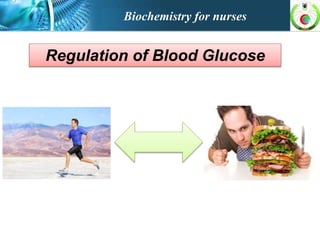
Regulation of blood glucose
- 1. Biochemistry for nurses Regulation of Blood Glucose
- 2. Biochemistry for nurses Alternation between Anabolism and Catabolism The human body alternates between Anabolic and Catabolic states: Anabolism: • Synthesis of complexe molecules from smaller units (ex: from glucose to glycogen) • Growth (body size increases) • Needs energy (powered by catabolism) Catabolism: • Breaking down of large molecules into smaller units (ex: from starch to glucose) • Synthesis of ATP molecules (cellular respiration) Glucose Metabolism: The hormone Insulin supports Anabolic Activities. The hormone Glucagon supports catabolic Activities
- 3. ATP molecule is the source of ENERGY! Biochemistry for nurses Alternation between Anabolism and Catabolism
- 4. Biochemistry for nurses Glucose Metabolism (Anabolism + Catabolism)
- 5. Biochemistry for nurses The Brain requires Blood Glucose The Brain requires a constant supply of blood glucose Glucose is the only energy source for the brain (cannot use fats!) Hypoglycemia (low blood glucose): Sometimes caused when diabetic takes too much of insulin (Insulin shock). Symptoms: Mental confusion, slurring of speech, coma and then death Treatment: Give glucose.
- 6. Biochemistry for nurses Blood Glucose is controlled mainly by the Liver Immediately after meals, blood glucose comes from meal. Between meals (starvation), blood glucose comes from the Liver and Kidneys. During starvation, Liver provides 80% of blood glucose and the Kidneys provide 20% of blood glucose.
- 7. Biochemistry for nurses Blood Glucose is controlled mainly by the Liver Liver makes glucose in 2 ways: 1) Breaks down liver glycogen (glycogenolysis) 2) Converts other types of small molecules into glucose (gluconeogenesis), many small molecules can be converted to glucose: Lactate and Pyruvate: Mainly come from muscular activity. Glycerol: supplied by adipose tissue when triglycerides are broken down (Fats). Amino Acids: 20 of the 22 amino acids can be converted to glucose.
- 8. Biochemistry for nurses Blood Glucose is controlled mainly by the Liver Delivery of glucose to the blood is controlled by Insulin and Glucagon. Brain receives a constant 80 mg/min (does not change much in exercice) Amount delivered of glucose to other tissues depends upon body state (rest or exercice) At rest total glucose output to the blood is about 130 mg/min (80 to brain, 50 to other tissues) During exercice total can increase to about 2500 mg/min
- 9. Biochemistry for nurses Insulin is the only hormone that can lower blood glucose Muscle, adipose and liver tissues require Insulin to transport glucose into the cells: In these tissues, Insulin increases the number of glucose transporters in the cell membrane. Brain does not require Insulin to transport Glucose into cells After a meal, blood sugar rises and this stimulates the release of Insulin from the pancreas Insulin stimulates the synthesis of Glycogen (glycogenesis) for the storage of glucose. Average Blood Glucose level = 0.8 to 1.4 g/l
- 10. Biochemistry for nurses Glucagon can raise blood glucose Between Meals, when blood glucose is low a large amount of Glucagon is secreted by the pancreas which rises blood sugar (glycogenolysis). Other hormones can also raise blood glucose especialy during stress and vigorous exercice. They are 3 major hormones: 1) Cortisol secreted by adrenal glands (situated above the kidneys) in response to stress and low blood glucose 2) Adrenaline secreted by adrenal glands (brain and above kidneys) in response of extrem stress 3) Growth hormone is also a stress hormone secreted by the Adenohypophysis (Brain) which raises blood glucose and stimulates growth cell reproduction and cell regeneration. Glucagon raises Blood Glucose Insulin lowers Blood Glucose
- 11. Biochemistry for nurses Diabetes Mellitus Diabetes = excess production of urine Mellitus = Sweet (refers to sugar in urine) Diabetes Mellitus results when Insulin is deficient or Ineffective Type 1: (Insulin is deficient) Occurs early in life due to autoimmune destruction of pancreatic cells. Low Insulin output High blood glucose Glucose in urine Excess urine flow Treated with Insulin injections, careful balance of diet and exercise is advised. Diabetes Mellitus is of 2 types:
- 12. Biochemistry for nurses Type 2: (Insulin is Ineffective) Occurs later in life associated with Obesity. Insulin is normal but is ineffective (Insulin resistance) Many of the symptoms are same but less severe (high blood glucose, glucose in urine and excess urine flow) Cause is unknown, but may be insulin receptor disease May be reversed if weight is lost. Diabetes Mellitus is of 2 types: